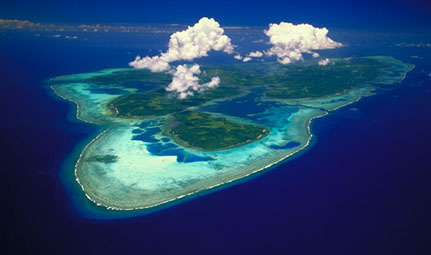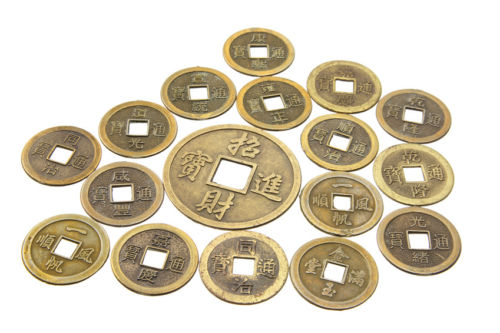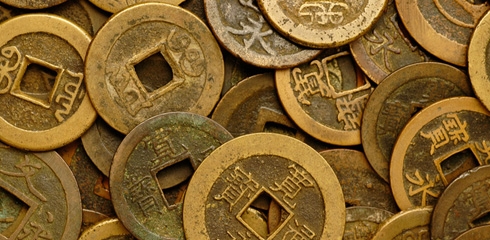It looks like you're using an Ad Blocker.
Please white-list or disable AboveTopSecret.com in your ad-blocking tool.
Thank you.
Some features of ATS will be disabled while you continue to use an ad-blocker.
8
share:
On the island of Yap in Micronesia, the locals have a series of giant stone discs with holes carved into the center of them, called Rai stones.
The stone is a kind of limestone which is not found on the Island of Yap, so the suggested quarry site of these is of Palau.
Palau is another island in Micronesia, which lies approximately 450km away. There is no one size for these giant stone discs but the largest of seem to be about 3m in diameter and weighing 5 tons or so. So not huge in contrast to most monoliths worldwide, but big enough to be a struggle. They then using the stars and tides sailed these back to Yap. The only known location of these Rai stones.
Scholars, puzzled initially, have suggested that these discs are in fact giant coins, a form of money used extensively on the Island of Yap.
According to all sources I can find, the size of the stone was not enough to make it worth more, it was the story of the stone that held the value.
Does anyone on here have anything more to add on these giant stone money?
link: www.npr.org...
The stone is a kind of limestone which is not found on the Island of Yap, so the suggested quarry site of these is of Palau.
Palau is another island in Micronesia, which lies approximately 450km away. There is no one size for these giant stone discs but the largest of seem to be about 3m in diameter and weighing 5 tons or so. So not huge in contrast to most monoliths worldwide, but big enough to be a struggle. They then using the stars and tides sailed these back to Yap. The only known location of these Rai stones.
Scholars, puzzled initially, have suggested that these discs are in fact giant coins, a form of money used extensively on the Island of Yap.
According to all sources I can find, the size of the stone was not enough to make it worth more, it was the story of the stone that held the value.
Does anyone on here have anything more to add on these giant stone money?
link: www.npr.org...
a reply to: Judgie
A couple of coins equals pocket change.
I prefer to think of their being used for a more practical purpose, such as milling grain or something. They are just too big for practical use. It makes me wonder why they would not cut several smaller ones. But hey, maybe they cut it that way to place atop their local bank
A couple of coins equals pocket change.
I prefer to think of their being used for a more practical purpose, such as milling grain or something. They are just too big for practical use. It makes me wonder why they would not cut several smaller ones. But hey, maybe they cut it that way to place atop their local bank
Im in possession of some pretty big stones i cannot remove from my back yard if anyone is interested in trading a house or a car
I am mostly interested in how a stone age group, not possessing any metal tools, was able to quarry these on an island 450km away. While looking
through google images I also notice amazing flat edges on some of these stone disks.
I don't doubt that they used them as money at some point, I just doubt that they/their ancestors, sailed all the way to Palau, to get them and sail backed back. For a primitive society it seems a little far fetched don't you think?
To me, it seems the stones could have been there long before the people. With everything else made up since then.
I'm just curious is all.
I don't doubt that they used them as money at some point, I just doubt that they/their ancestors, sailed all the way to Palau, to get them and sail backed back. For a primitive society it seems a little far fetched don't you think?
To me, it seems the stones could have been there long before the people. With everything else made up since then.
I'm just curious is all.
This form of currency has always fascinated me. I seem to remember reading about giant wheels/discs of salt and other materials being used by various
tribes and cultures. I have been unable to find reference online backing that up though. Will keep looking. Great thread - thanks!
edit on 2/5/15 by GENERAL EYES because: grammar edit
a reply to: Judgie
Judgie,
The stones are not "money" as we think of it, but more of a sign of status within the community.
An individual would have to be able to gather together the resources to be able to mount an expadition to obtain a stone.
He would have had to get a sizable group of people, including crafstmen and laborers, them have the canoes availabe to make the journey and he would hasve had to feed all those people during the expedition. If you were able to keep everyone working and finish the stone and get it back home you were a person of high standing in the community. That would lead to better deals when trading with others and a larger share of any communal goods.
The idea behind the stones is exactly the same idea behind the stone spheres of central america, they are signs of socail status.
Judgie,
The stones are not "money" as we think of it, but more of a sign of status within the community.
An individual would have to be able to gather together the resources to be able to mount an expadition to obtain a stone.
He would have had to get a sizable group of people, including crafstmen and laborers, them have the canoes availabe to make the journey and he would hasve had to feed all those people during the expedition. If you were able to keep everyone working and finish the stone and get it back home you were a person of high standing in the community. That would lead to better deals when trading with others and a larger share of any communal goods.
The idea behind the stones is exactly the same idea behind the stone spheres of central america, they are signs of socail status.
a reply to: punkinworks10
Or there were still giant humanoids during this time period & these were like coins to them.
Or there were still giant humanoids during this time period & these were like coins to them.
originally posted by: Eunuchorn
a reply to: punkinworks10
Or there were still giant humanoids during this time period & these were like coins to them.
Only problem with that idea is the people of Yap were doing it well into the 20th century and were photographed making and moving the stones.
Giants, please
if those are the coins, can you imagine the pockets!?!
And the piggy bank industry wust have been huge for this culture... Get it?! Do you get it?!
Waka waka waka!?
Y'all can't see it but my bowtie is spinning
And the piggy bank industry wust have been huge for this culture... Get it?! Do you get it?!
Waka waka waka!?
Y'all can't see it but my bowtie is spinning
I guess that limestone is easier to carve that granite or other volcanic rock. If someone wanted social status, wouldn't the skeleton or head of some
large creature do instead? Limestone gradually dissolves in water so that may or may not be practical for milling grain. If they were used for
milling, then eventually the two stones would become extremely polished.
a reply to: stormcell
Well other than the obvious erosion on the discs through time, it does appear that they are somewhat polished to me. But hey, I havn't been there to actually measure this, I am relying on the photos I can see which is kind of sub par. This is the remarkable thing tho, yes you could quarry limestone with other stone tools. I guess it really comes down to why they did this. I find it hard to believe that they extended all this effort to invent a money system as apposed to inheriting a bunch of weird rocks and assigning value to them later. The smooth finish on them is amazing and though 5 tons isn't a huge weight, it would require at least 50 men to carry this. Though they are round so they can be rolled which makes this a little bit easier I guess. But how would a people with big round discs not invent a wheel? I know they didn't have animals on the island to pull a cart but even a wheel barrow or something else surely would have been achievable by this standard.
I am somewhat puzzled with this.
Well other than the obvious erosion on the discs through time, it does appear that they are somewhat polished to me. But hey, I havn't been there to actually measure this, I am relying on the photos I can see which is kind of sub par. This is the remarkable thing tho, yes you could quarry limestone with other stone tools. I guess it really comes down to why they did this. I find it hard to believe that they extended all this effort to invent a money system as apposed to inheriting a bunch of weird rocks and assigning value to them later. The smooth finish on them is amazing and though 5 tons isn't a huge weight, it would require at least 50 men to carry this. Though they are round so they can be rolled which makes this a little bit easier I guess. But how would a people with big round discs not invent a wheel? I know they didn't have animals on the island to pull a cart but even a wheel barrow or something else surely would have been achievable by this standard.
I am somewhat puzzled with this.
originally posted by: Judgie
a reply to: stormcell
Well other than the obvious erosion on the discs through time, it does appear that they are somewhat polished to me. But hey, I havn't been there to actually measure this, I am relying on the photos I can see which is kind of sub par.
If you had taken the time to engage in even the most modest research on the topic on your own you might have come across this little factoid regarding the gentleman who introduced modern tools to the process in the mid 19th century. It caused some serious inflation and devaluation of some Rai because it was easier and faster to quarry the pieces with the new iron tools. This is why you will see some that have a smoother appearing sheen to them.
This is the remarkable thing tho, yes you could quarry limestone with other stone tools. I guess it really comes down to why they did this. I find it hard to believe that they extended all this effort to invent a money system as apposed to inheriting a bunch of weird rocks and assigning value to them later.
As noted previously, it wasn't so much a system of monetary exchange as it was a sign of status and wealth. They weren't rolling these down the street to the local 5 & dime for a soda pop. They were held in trust at a central location and used for large exchanges. Dowry's, land transfers...things of that nature. They were not however used for everyday commerce which is the implication you seem to be making and so incredulous about.
The smooth finish on them is amazing and though 5 tons isn't a huge weight, it would require at least 50 men to carry this. Though they are round so they can be rolled which makes this a little bit easier I guess. But how would a people with big round discs not invent a wheel? I know they didn't have animals on the island to pull a cart but even a wheel barrow or something else surely would have been achievable by this standard.
I am somewhat puzzled with this.
its the number of people it would take to quarry, finish and bring back from Palau that made these valuable back home. The larger the party one brought to Palau and back, the larger and more significant your social status would be and the more perceived your wealth would be.
As for the wheel issue, perhaps they simply didn't see a need for them? The Aztec for example also never used the wheel for transport and they would have had access to animals large enough to pull carts and also crafted children's toys with wheels. Yet they never used the wheel for anything else. In some cases, its more of a geographic issue due to the terrain of the area. The Aztecs likely had enough slaves to do their heavy lifting that they didn't see any point in utilizing the wheel in the local terrain. I'm not familiar enough with the terrain of the Caroline Islands to know for sure how useful wheeled implements would be aside from the fact that they are mostly volcanic and coral islands and atolls.

new topics
-
Thanksgiving 2024
Member Art: 2 hours ago -
The art of being offended
Social Issues and Civil Unrest: 4 hours ago -
FLORIDA Sues Biden-Harris FEMA for Denying Disaster Assistance to Homeowners with TRUMP Signs.
US Political Madness: 5 hours ago -
Turns out, they planned to go after P-nut.
US Political Madness: 9 hours ago
top topics
-
Comcast dumping MSNBC
Mainstream News: 17 hours ago, 22 flags -
Turns out, they planned to go after P-nut.
US Political Madness: 9 hours ago, 19 flags -
The art of being offended
Social Issues and Civil Unrest: 4 hours ago, 14 flags -
FLORIDA Sues Biden-Harris FEMA for Denying Disaster Assistance to Homeowners with TRUMP Signs.
US Political Madness: 5 hours ago, 11 flags -
Sick sick sick ---graphic story
Social Issues and Civil Unrest: 15 hours ago, 7 flags -
Thanksgiving 2024
Member Art: 2 hours ago, 2 flags
active topics
-
The art of being offended
Social Issues and Civil Unrest • 21 • : Kaiju666 -
Thanksgiving 2024
Member Art • 3 • : chr0naut -
FLORIDA Sues Biden-Harris FEMA for Denying Disaster Assistance to Homeowners with TRUMP Signs.
US Political Madness • 26 • : grey580 -
Should we look for the truth, or just let it go?
US Political Madness • 120 • : chr0naut -
Elon's Starlink Stole The Election For Trump--Leftist Conspiracy Theorists Charge
General Conspiracies • 43 • : ADVISOR -
Turns out, they planned to go after P-nut.
US Political Madness • 26 • : Dalamax -
President-elect TRUMP Picks MATT GAETZ for his ATTORNEY GENERAL - High Level PANIC Ensues.
2024 Elections • 56 • : fringeofthefringe -
President-Elect DONALD TRUMP's 2nd-Term Administration Takes Shape.
Political Ideology • 182 • : matafuchs -
Breaking: FBI Agents Raid Polymarket CEO After Betting Site Predicts Trump Win
General Conspiracies • 23 • : Tolkien -
Judge’s Dismissal of Classified Document Case Against Trump Explained
Other Current Events • 24 • : WeMustCare
8




